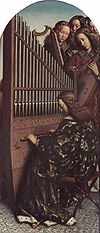4.4 Musical instruments used in Cuban music in the 16th century.

The Spanish introduced several musical instruments to Cuba, not only plucked string instruments, but also musical instruments that were initially used for religious and popular purposes, such as the organ, violin, viola, and fifes.
The organ is a keyboard musical instrument. Sounds are produced by passing air through tubes of varying lengths (from a few millimeters to several meters). It is classified as a wind instrument or aerophone in the keyboard instruments category and also within the air-blown subcategory, along with the accordion and the harmonium. It has different registers or sounds; the timbre depends on the shape, size, material, or sound-producing mechanism. The organ is played with the hands and feet. It has one or more keyboards for playing with the hands, and pedals at the bottom. The different registers can be obtained through levers or buttons within reach of the player.
The violin is a bowed string instrument with four strings tuned in fifths. Violin music scores are almost always written in the treble clef, formerly known as the “violin clef.” Unlike the guitar, the violin has no frets, making it difficult to learn. It is the smallest and highest-pitched of the stringed instrument family, which includes the viola, cello, and double bass.
The viola belongs to the string instrument family. It is very similar in materials and construction to the violin, but larger and with more variable proportions. Its range lies between the lower registers of the violin and the upper registers of the cello and double bass. It is considered the contralto or dramatic tenor of the string family. The viola’s strings are tuned in fifths, just like those of the violin.
The fife is a musical instrument belonging to the wind family, consisting of a small flute with a very high register and played crosswise. It has traditionally been used for military music, played by infantry accompanied by the snare drum. Later, its use expanded to the marching bands or brass bands of infantry regiments, with the exception of the halberdier companies, which continued to use it as before.








